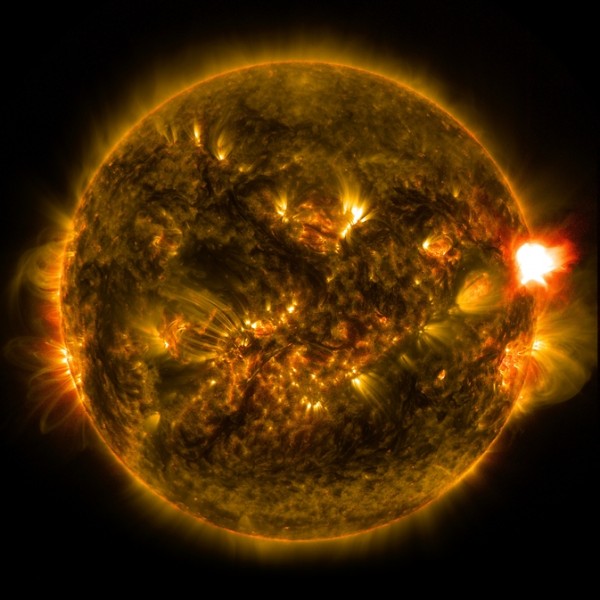
Researchers at NCAR (the National Center for Atmospheric Research) reported today (April 7, 2015) that our sun undergoes a type of seasonal variability that waxes and wanes over nearly two years. The researchers say this two-year cycle affects peaks and valleys in the better-known 11-year cycle of the sun. It acts to sometimes amplify – and sometimes weaken – the solar storms that can buffet Earth’s atmosphere. Two-year solar variations appear to be driven by changes in the bands of strong magnetic fields in the sun’s northern and southern hemispheres. The study is published this week in the journal Nature Communications.
Scott McIntosh, lead author of the new study and director of NCAR’s High Altitude Observatory, said:
What we’re looking at here is a massive driver of solar storms.
EarthSky’s annual fund-raising campaign is coming into the home stretch. Help EarthSky keep going!
He said scientists are trying to understand how the rotation of the sun’s deep interior drives these activity bands on the sun, with the goal of improving forecasts of space weather events. These events have the potential to affect our human satellite operations, communications, power grids, and other technologies.
On the sun, the magnetic activity bands move within the sun’s northern and southern hemispheres. The scientists found that they cause solar activity to rise to a peak over a period of 11 months, and then begin to wane.
McIntosh said these quasi-annual variations can be likened to regions on Earth that have two seasons, such as a rainy season and a dry season.
The authors conclude that the migrating bands produce seasonal variations in solar activity that are as strong as the more familiar 11-year cycle.
The two-year cycle helps shape the 11-year solar cycle, which in turn is part of a longer cycle that lasts about 22 years. NCAR added in a statement:
The new study is one of a series of papers by the research team that examines the influence of the magnetic bands on several interrelated cycles of solar magnetism. In a paper last year in Astrophysical Journal, the authors characterized the approximately 11-year sunspot cycle in terms of two overlapping parallel bands of opposite magnetic polarity that slowly migrate over almost 22 years from high solar latitudes toward the equator, where they meet and terminate.
McIntosh and his co-authors detected the twisted, ring-shaped bands by drawing on a host of NASA satellites and ground-based observatories, which gather information on the sun’s structure and on the nature of solar flares and coronal mass ejections (CMEs).
These observations revealed the bands in the form of fluctuations in the density of magnetic fuel that rose from the solar interior through a transition region known as the tachocline and on to the surface, where they correlated with changes in flares and CMEs.
Co-author Robert Leamon, a scientist at Montana State University, said:
Much like Earth’s jet stream, whose warps and waves have had severe impact on our regional weather patterns in the past couple of winters, the bands on the sun have very slow-moving waves that can expand and warp it too.
Sometimes this results in magnetic fields leaking from one band to the other. In other cases, the warp drags magnetic fields from deep in the solar interior, near the tachocline, and pushes them toward the surface.
The magnetic surges from the sun’s interior catastrophically destabilize the sun’s corona, or outermost atmosphere, the scientists said. They’re the driving force behind the most destructive solar storms. McIntosh said:
These surges or ‘whomps’ as we have dubbed them, are responsible for over 95 percent of the large flares and CMEs—the ones that are really devastating.
The two-year variability can also help explain a cold-war era puzzle: why do powerful solar flares and CMEs often peak a year or more after the maximum number of sunspots? This lag is known as the Gnevyshev Gap, after the Soviet scientist who first reported it in the 1940s.
The answer appears to be that seasonal changes may cause an upswing in solar disturbances long after the peak in the solar cycle has passed.

Bottom line: We are all somewhat familiar with an 11-year cycle of variability on the sun. For example, the number of spots on the sun’s surface – and the number of incoming solar storms – waxes and wanes over this 11-year cycle. Now scientists are reporting a two-year solar cycle of activity, which is driven by moving bands of magnetic fields in the sun’s northern and southern hemispheres. The two-year cycle is superimposed on the 11-year cycle and affects its peaks and valleys.











